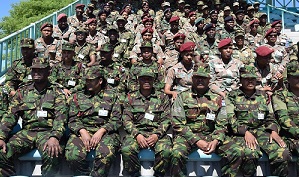
Understanding the SADC Standby Force

By Kizito Sikuka
Peace and security are necessary preconditions for sustainable development and deeper regional integration.
In this regard, the Southern African Development Community (SADC) continues to place top priority on developing and strengthening cooperation among the 16 Member States.
One joint initiative in the area of peace and security is the SADC Standby Force, or Brigade, which was established by SADC Heads of State and Government through a Memorandum of Understanding (MoU) signed in Lusaka, Zambia in August 2007.
The SADC Standby Force is a regional, multidimensional, peace-support operations capability established under the framework of the African Standby Force (ASF).
This represents a commitment of purpose that ensures a collective approach to defence and security, protecting people and safeguarding the stability of the region.
The Standby Force operates as a tool of the SADC Organ on Politics, Defence and Security Cooperation and receives its direction and guidance from the SADC Committee of Chiefs of Defence staff and the Committee of SADC Police Chiefs to provide peace-building efforts in the region.
These peace-building efforts include post-conflict disarmament and demobilisation and humanitarian assistance in conflict areas and in areas impacted by major natural disasters such as drought and floods.
The Force is made up of multidisciplinary contingents of the Military, Police and Civilians who are stationed in their countries of origin and ready for deployment when necessary. Other support mechanisms could be in the form of logistical and medical services.
The SADC Standby Force does not actually have a physical presence as the Force is constituted when the need arises.
The size of the regional Force is also not fixed but depends on the nature of the assignment as well as what individual Member States are able to contribute.
For every mission, SADC appoints a Force Commander, Commissioner of Police and Head of the Civilian Component to lead the operation.
The SADC Standby Force is deployed on the authority of the SADC Summit, ensuring that SADC leaders have the final say on the deployment and objectives.
In preparation for its responsibility, the SADC Standby Force conducts various drills and exercises such as Exercise UMODZI held in 2018 and Exercise AMANI Africa II in 2015, and became fully operational in 2017.
Some of the preparatory work for the Exercises is conducted at the SADC Regional Peacekeeping Training Centre (RPTC) located in Harare, Zimbabwe which hosts Scenario Development Workshops and Integrated Exercise Planning Courses.
These courses are aimed at strengthening the Exercise planning by sharing essential skills and techniques such as mastering the appropriate attitudes required for effective coordination of integrated multi-dimensional Exercises.
The RPTC also delivers training for peacekeeping practitioners from the SADC region and other parts of Africa, and has participated in the preparation and running of all major peacekeeping exercises conducted in the region.
The RPTC contributes to the core objectives of the SADC Organ on Politics, Defence and Security Cooperation, as one of the main implementing entities in training for military, police and civilian components for peace support missions in the region, and also conducts capacity-building courses for regional and national mediation to improve and strengthen domestic mediation capacities in SADC Member States.
According to the MoU establishing the SADC Standby Force, the SADC Heads of State and Government agreed on the need to establish a main logistics depot in one of the Member States.
The depot will provide storage, inspection and maintenance facilities for equipment and materials for all components of the SADC Standby Force.
The construction of the SADC Regional Logistics Depot is progressing well in the Rasesa village on the outskirts of Gaborone in Botswana.
Major equipment and other materials for the depot will be contributed by Member States. In this regard, the main aim of the depot is to provide stocks on a just in time basis to meet the rapid deployment capability of the SADC Standby Force to support regional peace operations.
SADC has also adopted a Counter-Terrorism Strategy in 2015, intended to strengthen the regions peace and security architecture by enabling a common approach.
This collective approach includes the sharing of information on suspected terrorists; enacting and reviewing legislation at national level on preventing and combatting terrorism; and strengthening capacity of the Financial Intelligence Units.
The SADC Standby Force is one of the building blocks of the ASF, a continental peacekeeping force established by the African Union (AU) and comprising Military, Police and Civilian components that are on standby in their regions of origin and available to the AU for deployment in times of need.
The ASF, which became operational in January 2016, draws from Africas five sub-regions of North Africa, East Africa, Central Africa, West Africa and Southern Africa.
The SADC Standby Force successfully assumed its rotational leadership of the ASF on 1 January 2019 for six months up to the end of June 2019, accepting the primary responsibility of being the first responder to conflict situations on the continent by providing a rapid deployment capability. sardc.net











































